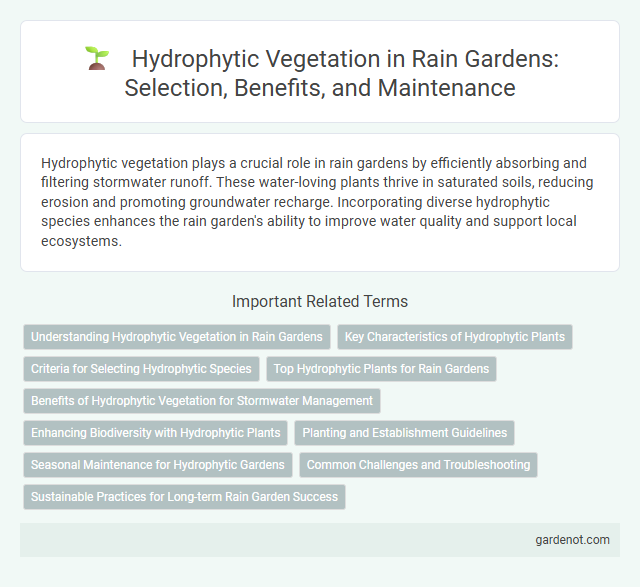Hydrophytic vegetation plays a crucial role in rain gardens by efficiently absorbing and filtering stormwater runoff. These water-loving plants thrive in saturated soils, reducing erosion and promoting groundwater recharge. Incorporating diverse hydrophytic species enhances the rain garden's ability to improve water quality and support local ecosystems.
Understanding Hydrophytic Vegetation in Rain Gardens
Hydrophytic vegetation in rain gardens consists of water-loving plants that thrive in saturated soil conditions, playing a vital role in stormwater management by absorbing excess water and filtering pollutants. These plants facilitate nutrient uptake and provide habitat for beneficial microorganisms, enhancing the garden's ecological function and water quality improvement. Selecting native hydrophytic species tailored to local climate and soil conditions optimizes rain garden performance and sustainability.
Key Characteristics of Hydrophytic Plants
Hydrophytic vegetation in rain gardens features plants adapted to saturated soil conditions, often possessing aerenchyma tissues that facilitate oxygen transport to submerged roots. These plants exhibit tolerance to periodic flooding and anoxic environments, with adaptations like shallow root systems and waxy cuticles to reduce water loss. Common examples include sedges, rushes, and pickerelweed, which enhance stormwater infiltration and pollutant removal through their root structures.
Criteria for Selecting Hydrophytic Species
Hydrophytic vegetation in rain gardens must be selected based on tolerance to periodic flooding, ability to thrive in saturated soil conditions, and adaptability to local climate zones. Species with deep root systems enhance soil infiltration and help maintain water quality by filtering pollutants. Selecting native hydrophytic plants that support local biodiversity and require minimal maintenance ensures sustainable performance and ecological benefits.
Top Hydrophytic Plants for Rain Gardens
Top hydrophytic plants for rain gardens include species like Carex stricta (tussock sedge), Juncus effusus (soft rush), and Pontederia cordata (pickerelweed), which thrive in saturated soil conditions. These plants enhance water filtration, reduce runoff, and support local biodiversity by providing habitat for pollinators and aquatic organisms. Selecting native hydrophytic vegetation ensures optimal adaptation to regional hydrology and improves the sustainability of rain garden ecosystems.
Benefits of Hydrophytic Vegetation for Stormwater Management
Hydrophytic vegetation plays a crucial role in stormwater management by enhancing water infiltration and reducing surface runoff through its deep root systems. These plants filter pollutants and trap sediments, improving water quality in urban landscapes. Their ability to thrive in saturated soils supports the natural attenuation of contaminants and mitigates flood risks in rain gardens.
Enhancing Biodiversity with Hydrophytic Plants
Hydrophytic vegetation in rain gardens plays a crucial role in enhancing biodiversity by providing habitat and food sources for a variety of aquatic and terrestrial species. These plants improve water quality through phytoremediation, promoting healthier ecosystems and supporting diverse microbial communities. Incorporating native hydrophytic species such as pickerelweed, cattails, and bulrushes increases resilience and ecological balance in urban stormwater management systems.
Planting and Establishment Guidelines
Hydrophytic vegetation selection for rain gardens should prioritize native species adapted to periodic flooding and saturated soil conditions, ensuring effective water filtration and habitat support. Planting should occur during early spring or fall to optimize root establishment and minimize water stress, with spacing based on mature plant size to prevent overcrowding and promote healthy growth. Proper mulch application and initial irrigation maintain moisture levels, facilitating successful establishment and long-term resilience of the rain garden ecosystem.
Seasonal Maintenance for Hydrophytic Gardens
Seasonal maintenance for hydrophytic gardens involves managing hydrophytic vegetation to ensure optimal water filtration and habitat function throughout the year. Regular pruning of native sedges, rushes, and wetland grasses prevents overcrowding and promotes healthy growth during wet and dry seasons. Inspecting and removing invasive species in spring and fall supports biodiversity and maintains the garden's ability to absorb and filter stormwater effectively.
Common Challenges and Troubleshooting
Hydrophytic vegetation in rain gardens often faces challenges such as poor soil drainage, prolonged flooding, and nutrient imbalances, which can lead to root rot and plant stress. Selecting native plant species with high tolerance to variable moisture levels helps mitigate these issues, while regular monitoring and soil amendments improve vegetation health. Addressing pest infestations and invasive species early ensures the sustainability and effectiveness of the rain garden's hydrophytic ecosystem.
Sustainable Practices for Long-term Rain Garden Success
Hydrophytic vegetation in rain gardens plays a crucial role in sustainable stormwater management by absorbing excess water and filtering pollutants through deep root systems. Selecting native plants like sedges, rushes, and wetland grasses enhances soil infiltration and supports local biodiversity, promoting ecosystem resilience. Proper maintenance, including periodic mulching and avoiding chemical fertilizers, ensures long-term plant health and effective water retention for continuous environmental benefits.
Hydrophytic vegetation Infographic

 gardenot.com
gardenot.com